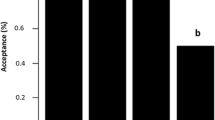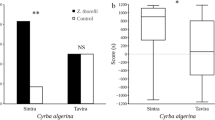Abstract
In Los Baños in the Philippines (Laguna, Luzon), Scytodes sp. indet. is a web-building spitting spider (Scytodidae) that preys primarily on jumping spiders (Salticidae) and Portia labiata is an aggressive-mimic jumping spider that preys especially frequently on Scytodes. Tactics by which three species of Portia (P. africana, P. fimbriata, and P. labiata) and, for Portia labiata, three disjunct populations (Sri Lanka and, in the Philippines, Sagada and Los Baños) capture this especially dangerous prey are compared. Local adaptation to Scytodes by the Los Baños P. labiata is discussed. The Los Baños P. labiata uniquely made consistent use of tactics (soft plucking with palps and signal–detour–leap sequences) that were apparently responsible for greater prey-capture success and more effective avoidance of being spat on. Inter- and intraspecific differences were evident despite having used Portia that were reared in the laboratory with no prioir experience with scytodids.
Similar content being viewed by others
REFERENCES
Chapuis, N. (1987). Detour and shortcut abilities in several species of mammals. In Ellen, P., and C. Thinus-Blanc, C. (eds.), Cognitive Processes and Spatial Orientation in Animals and Man, Martinus Nijhoff, Dordrecht, pp. 97–106.
Collett, T. S. (1982). Do toads plan detours? A study of the detour behaviour of Bufo viridis. J. Comp. Physiol. 146: 261–271.
Curio, E. (1976). Ethology of Predation, Springer-Verlag, Berlin.
Dabelow, S. (1958). Zur Biologie der Leimschleuderspinne Scytodes thoracica (Latreille). Zool. Jahb. Syst. 86: 85–126.
Foelix, R. F. (1982). Biology of Spiders, Harvard University Press, Cambridge, MA.
Gilbert, C., and Rayor, L. S. (1985). Predatory behavior of spitting spiders (Araneae: Scytodidae) and the evolution of prey wrapping. J. Arachnol. 13: 231–241.
Guilford, T., and Dawkins, M. S. (1991). Receiver psychology and the evolution of animal signals. Anim. Behav. 42: 1–14.
Heil, K. H. (1936). Beträge zur Physiologie und Psychologie der Springspinnen. Z. Vergl. Physiol. 23: 1–25.
Hill, D. E. (1979). Orientation by jumping spiders of the genus Phidippus (Araneae: Salticidae) during the pursuit of prey. Behav. Ecol. Sociobiol. 5: 301–322.
Jackson, R. R. (1985a). A web-building jumping spider. Sci. Am. 253: 102–115.
Jackson, R. R. (1985b). The biology of Euryattus sp. indet., a web-building jumping spider (Araneae: Salticidae) from Queensland: Utilization of silk, predatory behaviour and intraspecific interactions. J. Zool. Lond. B 1: 145–173.
Jackson, R. R. (1986). Web building, predatory versatility, and the evolution of the Salticidae. In Shear, W. A. (ed), Spiders: Webs, Behavior, and Evolution, Stanford University Press, Stanford, CA, pp. 232–268.
Jackson, R. R. (1990). Predator-prey interactions between jumping spiders (Araneae: Salticidae) and Pholcus phalangiodes (Araneae: Pholicidae). J. Zool. Lond. 220: 553–559.
Jackson, R. R. (1992a). Eight-legged tricksters: Spiders that specialize at catching other spiders. BioSciences 42: 590–598.
Jackson, R. R. (1992b). Conditional strategies and interpopulation variation in the behaviour of jumping spiders. N.Z. J. Zool. 19: 99–111.
Jackson, R. R. (1992c). Predator-prey interactions between web-invading jumping spiders and two species of tropical web-building pholcid spiders, Psilochrus sphaeroides and Smeringopus pallidus. J. Zool. Lond. 227: 531–536.
Jackson, R. R. (1992d). Predator-prey interactions between web-invading jumping spiders and a web-building spider, Holocnemus pluchei (Araneae, Pholcidae). J. Zool. Lond. 228: 589–594.
Jackson, R. R. (1992e). Predator-prey interactions between web-invading jumping spiders and Argiope appensa (Araneae, Araneidae), a tropical orb-weaving spider. J. Zool. Lond. 228: 509–520.
Jackson, R. R., and Blest, A. D. (1982). The biology of Portia fimbriata, a web-building jumping spider (Araneae: Salticidae) from Queensland: Utilization of webs and predatory versatility. J. Zool. Lond. 196: 255–293.
Jackson, R. R., and Brassington, R. J. (1987). The biology of Pholcus phalangiodes (Araneae, Pholcidae): Predatory versatility, araneophagy and aggressive mimicry. J. Zool. Lond. 211: 227–238.
Jackson, R. R., and Hallas, S. E. A. (1986a). Comparative biology of Portia africana, P. albimana, P. fimbriata, P. labiata and P. Schultzi, araneophagic web-building jumping spiders (Araneae: Salticidae): Utilisation of webs, predatory versatility and intraspecific interactions. N.Z. J. Zool. 13: 423–489.
Jackson, R. R., and Hallas, S. E. A. (1986b). Capture efficiencies of web-building jumping spiders (Araneae, Salticidae): Is the jack-of-all-trades the master of none? J. Zool. Lond. 209: 1–7.
Jackson, R. R., and Pollard, S. D. (1996). Predatory behavior of jumping spiders. Annu. Rev. Entomol. 41: 287–308.
Jackson, R. R., and Pollard, S. D. (1997). Jumping spider mating strategies: Sex among cannibals in and out of webs. In Choe, J., and Crespi, B. (eds.), Mating Systems in Insects and Arachnids, Cambridge University Press, Cambridge.
Jackson, R. R., and Whitehouse, M. E. A. (1986). The biology of New Zealand and Queensland pirate spiders (Araneae, Mimetidae): Aggressive mimicry, araneophagy, and prey specialization. J. Zool. Lond. 210: 279–303.
Jackson, R. R., and Wilcox, R. S. (1990). Aggressive mimicry, prey-specific predatory behaviour and predator-recognition in the predator-prey interactions of Portia fimbriata and Euryattus sp., jumping spiders from Queensland. Behav. Ecol. Sociobiol. 26: 111–119.
Jackson, R. R., and Wilcox, R. S. (1993a). Spider flexibly chooses aggressive mimicry signals for different prey by trial and error. Behaviour 127: 21–36.
Jackson, R. R., and Wilcox, R. S. (1993b). Observations in nature of detouring behaviour by Portia fimbriata, a web-invading aggressive mimic jumping spider from Queensland. J. Zool. Lond. 230: 135–139.
Jarman, E. A. R., and Jackson, R. R. (1986). The biology of Taieria erebus (Araneae, Gnaphosidae), an araneophagic spider from New Zealand: Silk utilisation and predatory versatility. N.Z. J. Zool. 13: 521–541.
Land, M. F. (1969a). Structure of the retinae of the principal eyes of jumping spiders (Salticidae: Dendryphantinae) in relation to visual optics. J. Exp. Biol. 51: 443–470.
Land, M. F. (1969b). Movements of the retinae of jumping spiders (Salticidae: Dendryphantinae) in response to visual stimuli. J. Exp. Biol. 51: 471–493.
Land, M. F. (1985). The morphology of optics of spider eyes. In Barth, F. G. (ed.), Neurobiology of Arachnids, Springer-Verlag, Berlin, pp. 53–78.
Li, D., Jackson, R. R., and Barrion, A. (In press). Parental and predatory behaviour of Scytodes sp., an araneophagic spitting spider (Araneae: Scytodidae) from the Philippines. J. Zool. Lond.
Masters, W. M., Markl, H. S., and Moffat, A. M. (1986). Transmission of vibrations in a spider's web. In Shear, W. A. (ed.), Spiders: Webs, Behavior, and Evolution, Stanford University Press, Stanford, CA.
McAlister, W. (1960). The spitting habit in the spider Scytodes intricata Banks (family Scytodidae). Tex. J. Sci. 12: 17–20.
Monterosso, B. (1928). Observazioni preliminar sella del genere Scytodes (Walk.) (Araneae verae: Sicariidae). Atti. Accad. Naz. Lincei Re. 6: 171–174.
Nentwig, W. (1985). Feeding ecology of the tropical spitting spider Scytodes longipes (Araneae, Scytodidae). Oecologia (Berlin) 65: 284–288.
Regolin, L., Vallortigara, G., and Zanforlin, M. (1994). Perceptual and motivational aspects of detour behaviour in young chicks. Anim. Behav. 47: 123–131.
Regolin, L., Vallortigara, G., and Zanforlin, M. (1995a). Object and spatial representations in detour problems by chicks. Anim. Behav. 49: 195–199.
Regolin, L., Vallortigara, G., and Zanforlin, M. (1995b). Detour behaviour in the domestic chick: Searching for a disappearing prey or a disappearing social partner. Anim. Behav. 50: 203–211.
Shear, W. A. (1994). Untangling the evolution of the web. Am. Sci. 82: 256–266.
Sokal, R. R., and Rohlf, F. J. (1981). Biometry: The Principles of Statistics in Biological Research, Freeman, San Francisco.
Tarsitano, M. S., and Jackson, R. R. (1993). Influence of prey movement on the performance of simple detours by jumping spiders. Behaviour 123: 106–120.
Tarsitano, M. S., and Jackson, R. R. (1994). Jumping spiders make predatory detours requiring movement away from prey. Behaviour 131: 65–73.
Tarsitano, M. S., and Jackson, R. R. (1997). Araneophagic jumping spiders discriminate between detour routes that do and do not lead to prey. Anim. Behav. 53: 257–266.
von Firsch, O. (1962). Zur Biologie des Zwergchamäleons (Microsaurus pumilus). Z. Tierpsychol. 19: 276–289.
Wanless, F. R. (1978). A revision of the spider genus Portia (Araneae: Salticidae). Bull. Br. Mus. Nat. Hist. 34: 83–124.
Whitehouse, M. E. A. (1986). The foraging behaviours of Argyrodes antipodiana (Araneae: Theridiidae), a kleptolarasitic spider from New Zealand. N.Z. J. Zool. 13: 151–168.
Witt, P. N. (1975). The web as a means of communication. Biosci. Commun. 1: 7–23.
Author information
Authors and Affiliations
Rights and permissions
About this article
Cite this article
Jackson, R.R., Li, D., Fijn, N. et al. Predator–Prey Interactions Between Aggressive-Mimic Jumping Spiders (Salticidae) and Araneophagic Spitting Spiders (Scytodidae) from the Philippines. Journal of Insect Behavior 11, 319–342 (1998). https://doi.org/10.1023/A:1020946529246
Issue Date:
DOI: https://doi.org/10.1023/A:1020946529246




